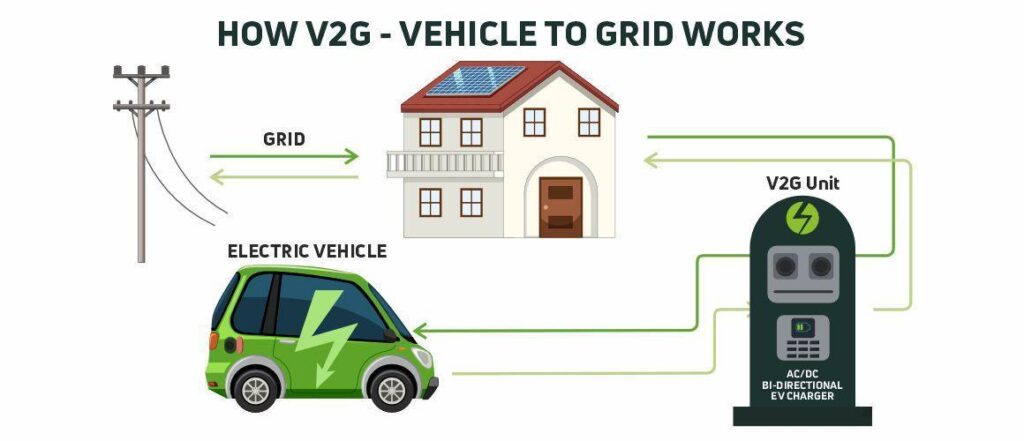Context: The Kerala State Electricity Board (KSEB) and the Indian Institute of Technology Bombay (IIT Bombay) have initiated a pilot project to explore the implementation of Vehicle-to-Grid (V2G) technology across the State. This collaboration aims to assess the feasibility of integrating Electric Vehicles (EVs) into the State’s power grid
Vehicle-to-Grid (V2G) Technology
1. What is V2G?
A system that allows Electric Vehicles (EVs) to:
Draw electricity from the grid for charging.
Return (discharge) electricity back to the grid when needed.
2. How It Works
EVs must be connected to a bi-directional charger.
When an EV is parked and not in use (e.g., at home or work), it can:
Discharge stored electricity into the grid.
Function as a temporary energy source.
3. Benefits
Transforms EVs into decentralised energy storage units.
Helps balance electricity supply and demand.
Supports grid stability, especially during peak demand or outages.
4. Extended Use Cases
Vehicle-to-Grid (V2G) – EVs support the national grid.
Vehicle-to-Home (V2H) – EV powers home during outages or peak hours.
Vehicle-to-Vehicle (V2V) – EV shares charge with another EV.
Among these, V2G is the most widely adopted and promising use case.

Benefits of V2G Technology
- Decentralised storage: EVs are mobile energy storage units that can operate independently of centralised power plants.
- Facilitates Renewable Energy Integration: EVs can store surplus energy generated during high RE output periods and feed it back during low generation times. Provides backup during peak load conditions.
- Emergency power source: In scenarios of climate-induced disasters (E.g., floods, storms), EVs can act as emergency power sources for homes, hospitals, or relief centers.
Global Application of Vehicle-to-Grid (V2G) Technology
1. Growing Adoption in Mature EV Markets
EVs = Cost-effective distributed energy storage: Owners are incentivised to supply stored energy back to the grid.
Europe & U.S. leading the charge:
U.K. & Netherlands: EV owners are compensated for feeding power into the grid during peak demand hours.
California, U.S.: EV users contribute to ancillary services—helping with grid reliability, frequency regulation, and load balancing.
Status of V2G Technology in India
1. Nascent Stage of Development
V2G is not yet mainstream in India, primarily due to:
Regulatory gaps
Infrastructure limitations
Focus on unidirectional charging expansion
2. Current Efforts and Developments
Most initiatives are focused on expanding EV charging networks, not bidirectional charging.
Some DISCOMs have launched pilot projects exploring:
Smart charging
Early V2G applications
The Central Electricity Authority (CEA) has:
Formed a committee to draft guidelines on reverse charging.
Identified smart charging as a key strategy for integrating EVs without overloading the grid.
Challenges in the Indian Context
1. Regulatory and Market Structure
The centralised, regulated electricity market in India limits decentralised participation like V2G.
No compensation model exists for EV owners supplying power back to the grid, reducing incentive.
2. Technical and Infrastructure Constraints
Most EV chargers in India are unidirectional.
Very few bi-directional chargers exist, and their compatibility with EV models is still evolving.
3. Renewable Energy (RE) Integration Issues
Variable RE supply (e.g., solar, wind) creates grid instability.
V2G could help balance this, but mismatches between supply and demand remain a technical hurdle.
